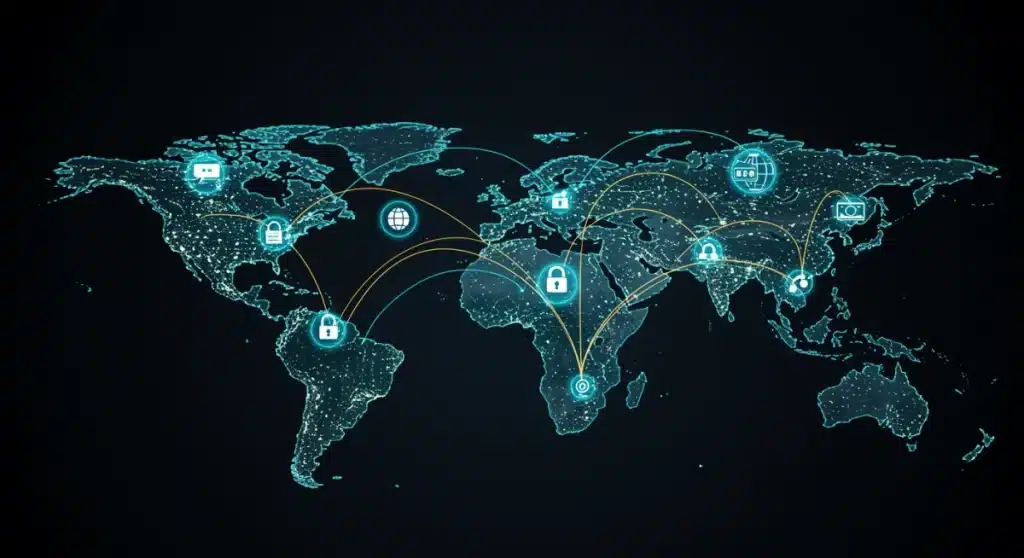U.S. Companies: Navigating Digital Silk Road Data Flows by 2025

U.S. companies must strategically navigate cross-border data flows on the Digital Silk Road by 2025 by adopting robust compliance frameworks, leveraging advanced technologies, and fostering international partnerships to ensure secure and efficient global data exchange.
Navigating the New Digital Silk Road: Practical Solutions for U.S. Companies to Leverage Cross-Border Data Flows by 2025 is no longer a distant concern but an immediate strategic imperative. As global digital infrastructure rapidly expands and geopolitical dynamics evolve, U.S. businesses face unprecedented challenges and opportunities in managing data across international borders. This article delves into the critical aspects of this new digital landscape, offering actionable insights for compliance and competitive advantage.
Understanding the Digital Silk Road’s Evolving Landscape
The Digital Silk Road (DSR), an initiative primarily driven by China, aims to build global digital infrastructure, including fiber optic cables, 5G networks, data centers, and e-commerce platforms. For U.S. companies, this expansion means both new markets and heightened regulatory complexities, particularly concerning data sovereignty and security. The landscape is dynamic, with policies shifting rapidly, demanding constant vigilance and adaptability from businesses operating internationally.
The DSR’s reach extends beyond physical infrastructure, encompassing digital trade agreements, technology standards, and data governance norms. U.S. companies must recognize that participation in this ecosystem, whether direct or indirect, means engaging with diverse legal frameworks and cultural expectations around data. The implications for intellectual property, consumer privacy, and national security are profound, necessitating a proactive approach to risk management and strategic planning.
Geopolitical Implications for U.S. Data Flows
The DSR is inherently intertwined with geopolitical competition, particularly between the U.S. and China. This rivalry often manifests in data policy, with countries aligning with different technological ecosystems and regulatory philosophies. U.S. companies find themselves caught in the middle, needing to comply with U.S. export controls and data protection laws while also operating in jurisdictions influenced by DSR partners. This dual challenge requires a nuanced understanding of international relations and their direct impact on data strategies.
- Data Sovereignty Laws: Many DSR-affiliated nations are enacting stricter data localization and sovereignty laws, requiring data generated within their borders to remain there. This complicates cloud computing strategies and global data processing.
- Technological Standards: The adoption of differing technical standards, particularly in 5G and AI, can create interoperability issues and data transfer bottlenecks. U.S. companies must assess compatibility and potential vendor lock-in risks.
- Supply Chain Vulnerabilities: Dependence on DSR-linked infrastructure or technology providers can introduce supply chain vulnerabilities, including potential for data interception or forced technology transfer.
Navigating these geopolitical currents demands that U.S. companies develop robust data governance policies that are resilient to political shifts. This includes diversifying technology providers, implementing strong encryption, and continuously monitoring international policy developments. A failure to adapt could result in significant legal penalties, reputational damage, and loss of market access.
Navigating the Regulatory Maze: Compliance Strategies
The sheer volume and diversity of international data regulations present a formidable challenge for U.S. companies. From the European Union’s GDPR to China’s PIPL, and various national data localization laws, compliance is a complex, multi-layered endeavor. By 2025, a patchwork of regulations will likely intensify, requiring a harmonized yet flexible approach to data governance.
Effective compliance is not merely about avoiding penalties; it’s about building trust with customers and partners. Companies that demonstrate a strong commitment to data privacy and security will gain a competitive edge. This involves not only understanding the letter of the law but also the spirit behind it, anticipating future regulatory trends, and embedding privacy-by-design principles into all data-related operations.
Key Regulatory Frameworks and Their Impact
U.S. companies must contend with a range of critical regulations that dictate how cross-border data can be collected, processed, stored, and transferred. These frameworks often have extraterritorial reach, meaning they apply to U.S. companies even if they don’t have a physical presence in certain countries, based on their handling of data belonging to residents of those nations.
- General Data Protection Regulation (GDPR) (EU): Sets stringent rules for processing personal data of EU residents, including requirements for data transfer mechanisms like Standard Contractual Clauses (SCCs) or Binding Corporate Rules (BCRs).
- Personal Information Protection Law (PIPL) (China): A comprehensive data protection law similar to GDPR, with strict requirements for cross-border data transfers, often necessitating separate consent and security assessments.
- Cloud Act (U.S.): Allows U.S. law enforcement to compel U.S.-based technology companies to provide requested data stored on servers anywhere in the world, potentially creating conflicts with foreign data sovereignty laws.
- National Data Localization Laws: Countries like India, Russia, and Vietnam have laws requiring certain types of data to be stored and processed within their national borders, impacting cloud service adoption and data architecture.
To navigate these diverse requirements, companies should establish a centralized data governance team responsible for monitoring regulatory changes, conducting regular data protection impact assessments (DPIAs), and implementing consistent policies across all jurisdictions. This team should work closely with legal counsel to ensure all data transfer mechanisms comply with the latest legal interpretations.
Implementing Robust Data Governance Frameworks
A strong data governance framework is the backbone of effective cross-border data flow management. It provides the policies, processes, and technologies necessary to ensure data is handled securely, ethically, and in compliance with all relevant laws. This framework should be dynamic, capable of adapting to new regulations and technological advancements.
Establishing clear data classification policies is a foundational step, identifying sensitive data that requires enhanced protection. Data mapping exercises are also crucial to understand where data resides, how it moves across borders, and who has access to it. This visibility is essential for conducting accurate risk assessments and demonstrating accountability to regulators.

Furthermore, U.S. companies must invest in employee training to ensure that all personnel understand their roles and responsibilities in data protection. Regular audits and reviews of data handling practices are also vital for identifying and addressing vulnerabilities before they lead to breaches or compliance failures. Proactive engagement with regulatory bodies can also help companies stay ahead of the curve and contribute to shaping future data policies.
Technological Solutions for Secure Data Flows
Technology plays a pivotal role in enabling secure and compliant cross-border data flows. As data volumes explode and cyber threats evolve, U.S. companies must leverage cutting-edge solutions to protect sensitive information and maintain operational efficiency. By 2025, reliance on advanced encryption, distributed ledger technologies, and sophisticated access controls will be paramount.
The right technological infrastructure not only facilitates compliance but also enhances business agility, allowing companies to quickly adapt to market changes and expand into new regions. Investing in robust, scalable solutions is therefore a strategic investment that can yield significant returns in terms of security, efficiency, and competitive advantage.
Advanced Encryption and Anonymization Techniques
Encryption remains the first line of defense for data in transit and at rest. U.S. companies should implement end-to-end encryption for all cross-border data transfers, ensuring that data is unintelligible to unauthorized parties. Homomorphic encryption, which allows computation on encrypted data without decrypting it, is an emerging technology that could revolutionize data privacy in collaborative environments.
- Strong Cryptographic Protocols: Utilize industry-standard and government-approved encryption algorithms (e.g., AES-256) for all data, both in transit and at rest.
- Tokenization and Pseudonymization: Replace sensitive data elements with non-sensitive substitutes (tokens) or use pseudonymization techniques to obscure direct identifiers, reducing the risk associated with data breaches.
- Multi-Party Computation (MPC): Explore MPC solutions that enable multiple parties to jointly compute a function over their inputs while keeping those inputs private, ideal for collaborative data analysis across borders without sharing raw data.
Beyond encryption, anonymization techniques can further reduce data risk. While full anonymization is challenging to achieve, effective pseudonymization can significantly mitigate risks by making it difficult to link data back to individuals without additional information. This is particularly useful for analytical purposes where individual identification is not required.
Leveraging Cloud and Edge Computing with Caution
Cloud computing offers unparalleled scalability and flexibility, but its cross-border nature introduces data residency and sovereignty challenges. U.S. companies must carefully select cloud providers and deploy architectures that support their compliance needs. Multi-cloud and hybrid cloud strategies can offer greater control over data location and resilience.
Edge computing, which processes data closer to its source, can help address data localization requirements by minimizing cross-border data transfers. By processing and storing data locally at the edge, companies can reduce latency, enhance security, and comply with regulations that mandate in-country data handling. However, managing distributed edge infrastructure also introduces new security and governance complexities.

When adopting cloud or edge solutions, due diligence is paramount. Companies should scrutinize service agreements, understand data processing locations, and ensure that providers offer robust security features and audit capabilities. Implementing strong access controls, identity management, and continuous monitoring are critical components of a secure cloud and edge strategy.
Building Trust and Transparency in Data Exchange
As data flows become more complex, trust and transparency are indispensable for U.S. companies. Customers, partners, and regulators increasingly demand clear communication about how data is collected, used, and protected. By fostering an environment of openness, businesses can enhance their reputation, build stronger relationships, and mitigate compliance risks.
Transparency is not just about legal disclosures; it’s about making data practices understandable and accessible to all stakeholders. This proactive approach helps to demystify complex data operations and demonstrates a genuine commitment to ethical data stewardship, which is crucial for long-term success in the global digital economy.
Clear Data Privacy Policies and User Consent
U.S. companies engaging in cross-border data flows must develop clear, concise, and easily accessible data privacy policies. These policies should articulate what data is collected, why it’s collected, how it’s used, and with whom it’s shared. Crucially, they must also inform individuals about their rights regarding their data, such as access, correction, and deletion.
Obtaining explicit and informed consent for data collection and processing is a cornerstone of privacy regulations like GDPR and PIPL. Companies must ensure that consent mechanisms are granular, allowing users to choose precisely what data they share and for what purposes. This often means implementing consent management platforms that track and manage user preferences across different services and jurisdictions.
- Plain Language: Avoid legal jargon in privacy policies; use simple, understandable language to explain data practices.
- Granular Consent: Provide options for users to consent to specific types of data processing, rather than a blanket agreement.
- Easy Withdrawal: Make it straightforward for users to withdraw their consent at any time, with clear instructions on how to do so.
Regularly reviewing and updating privacy policies is also essential to reflect changes in data practices, new technologies, and evolving legal requirements. Transparency in these updates helps maintain user trust and demonstrates a commitment to ongoing compliance.
Establishing Data Ethics Boards and Principles
Beyond legal compliance, U.S. companies should consider establishing internal data ethics boards or committees. These bodies can help guide ethical decision-making around data use, especially in complex cross-border scenarios where legal frameworks may be ambiguous or conflicting. An ethics board can ensure that data practices align with corporate values and societal expectations.
Developing a set of guiding data ethics principles can also provide a framework for responsible data stewardship. These principles might include fairness, accountability, transparency, security, and proportionality. By embedding these principles into corporate culture, companies can foster a responsible approach to data that extends beyond mere regulatory checklists.
Such initiatives not only enhance internal governance but also serve as a powerful signal to external stakeholders, including customers, investors, and regulators, that the company is committed to ethical data practices. This can differentiate U.S. companies in a crowded global marketplace and build enduring trust.
Leveraging Data for Competitive Advantage Amidst Challenges
Despite the complexities, cross-border data flows offer immense opportunities for U.S. companies to gain a competitive edge. Access to diverse global datasets can fuel innovation, enhance market intelligence, and optimize operational efficiency. The challenge lies in transforming these opportunities into tangible benefits while strictly adhering to compliance and security mandates.
Companies that master the art of secure and compliant data leveraging will be better positioned to understand global markets, personalize customer experiences, and develop groundbreaking products and services. This strategic approach turns perceived obstacles into drivers of growth and differentiation in the global economy.
Enhanced Market Intelligence and Product Development
Access to cross-border data allows U.S. companies to gain deeper insights into international markets, consumer preferences, and emerging trends. This intelligence is invaluable for tailoring products and services to specific regional needs, optimizing marketing campaigns, and identifying new growth opportunities. For example, analyzing purchase patterns across different countries can reveal unmet demands or cultural nuances that inform product localization strategies.
Data from diverse geographies can also accelerate product development cycles. By collecting feedback and usage data from a wider user base, companies can iterate faster, identify bugs more quickly, and launch more successful products. This global feedback loop is a powerful engine for innovation, provided the data is collected and processed ethically and compliantly.
Furthermore, cross-border data can help U.S. companies benchmark their performance against international competitors and identify best practices. This comparative analysis can drive operational improvements and strategic adjustments, ensuring that businesses remain competitive on a global scale. The ability to aggregate and analyze data from various sources provides a holistic view that single-market data simply cannot offer.
Optimizing Global Operations and Supply Chains
Efficient cross-border data flows are critical for optimizing global operations and supply chains. Real-time data on logistics, inventory, and demand from international markets enables companies to make informed decisions, reduce costs, and improve responsiveness. For instance, predictive analytics powered by global data can forecast supply chain disruptions, allowing for proactive mitigation strategies.
In manufacturing and distribution, data from sensors and IoT devices deployed across different countries can provide unprecedented visibility into operational performance. This data can be used to identify inefficiencies, optimize resource allocation, and ensure consistent quality across global production sites. The seamless flow of operational data is essential for maintaining a lean and agile global footprint.
Moreover, cross-border data facilitates better customer service and support for international clients. By centralizing customer data (while respecting privacy laws), companies can offer consistent and personalized support regardless of geographical location. This enhances customer satisfaction and loyalty, which are crucial for success in global markets. The integration of data from various operational touchpoints creates a unified view that drives efficiency and improves the overall customer experience.
Future-Proofing Strategies for 2025 and Beyond
As the Digital Silk Road continues to evolve, U.S. companies must adopt future-proofing strategies to remain resilient and competitive. This involves not only adapting to current changes but also anticipating future trends in technology, regulation, and geopolitics. A forward-looking approach ensures that investments today will continue to yield benefits in the years to come.
Building a culture of continuous learning and adaptation within the organization is crucial. This means empowering employees with the knowledge and tools to navigate complex data environments and fostering a mindset that embraces change rather than resisting it. Proactive engagement with industry peers, academic institutions, and policy makers can also provide valuable insights into future challenges and opportunities.
Investing in Data Talent and Training
The complexity of cross-border data flows necessitates a highly skilled workforce. U.S. companies must invest in recruiting and retaining data privacy professionals, cybersecurity experts, and legal counsel with international expertise. Training existing employees on data protection principles, regulatory requirements, and secure data handling practices is equally important.
Developing internal expertise reduces reliance on external consultants and ensures that data governance is deeply embedded within the organization’s operations. This includes training for all employees who handle personal data, from front-line staff to senior management, to create a pervasive culture of data responsibility. Specialized training for IT and legal teams on emerging technologies and international legal frameworks is also vital.
- Cross-Functional Training: Educate legal, IT, marketing, and sales teams on international data privacy laws and best practices.
- Certification Programs: Encourage employees to pursue certifications in data privacy (e.g., CIPP/E, CIPM) and cybersecurity.
- Continuous Learning: Establish platforms for ongoing education to keep pace with evolving regulations and technological advancements.
By prioritizing talent development, U.S. companies can build a robust internal capability to manage the intricacies of global data flows effectively and confidently, turning potential liabilities into strategic assets. This human capital investment is as critical as technological investment for long-term success.
Strategic Partnerships and Industry Collaboration
No single company can navigate the Digital Silk Road alone. Strategic partnerships with trusted vendors, local partners in foreign jurisdictions, and industry associations are essential. Collaborating with organizations that have established expertise in specific regions or regulatory environments can mitigate risks and accelerate market entry.
Participating in industry working groups and standards bodies can also help shape future data policies and best practices. By contributing to these discussions, U.S. companies can advocate for their interests, influence the development of interoperable standards, and gain early insights into upcoming regulatory changes. This collective action strengthens the position of U.S. businesses in the global digital arena.
Furthermore, partnerships can facilitate the adoption of shared data transfer mechanisms, such as industry-specific codes of conduct or certification schemes, which can streamline compliance across multiple jurisdictions. These collaborations foster a more predictable and secure environment for cross-border data flows, benefiting all participants. Collective intelligence and shared resources are powerful tools in addressing the challenges of the Digital Silk Road.
Key Strategy |
Brief Description |
|---|---|
Compliance Frameworks |
Implement robust governance for GDPR, PIPL, and local data laws. |
Technological Solutions |
Leverage encryption, pseudonymization, secure cloud, and edge computing. |
Trust & Transparency |
Develop clear policies, obtain explicit consent, and establish ethics boards. |
Future-Proofing |
Invest in talent, training, and strategic partnerships for long-term resilience. |
Frequently Asked Questions About Cross-Border Data Flows
The Digital Silk Road is China’s initiative to build global digital infrastructure. It’s relevant because it expands digital markets while introducing complex data sovereignty laws, differing technological standards, and geopolitical risks that U.S. companies must navigate for secure global operations.
U.S. companies face a complex web of regulations like GDPR, China’s PIPL, and various national data localization laws. These demand stringent compliance, often requiring specific consent mechanisms and data transfer impact assessments, creating a multi-layered compliance burden.
Technology like advanced encryption (e.g., homomorphic encryption), tokenization, and multi-party computation can secure data. Additionally, strategic use of secure cloud and edge computing architectures helps manage data residency and minimize cross-border transfer risks, enhancing compliance and protection.
▼
Trust and transparency are vital because customers and regulators demand clear communication on data collection, usage, and protection. Clear privacy policies, explicit user consent, and data ethics boards build reputation, strengthen relationships, and mitigate compliance risks in the evolving global data landscape.
▼
Companies should invest in data talent and training for privacy and cybersecurity, fostering a culture of continuous adaptation. Strategic partnerships with trusted vendors and industry collaborations are also essential to navigate technological, regulatory, and geopolitical shifts effectively and ensure long-term resilience.
What this means
The imperative for U.S. companies to master US Cross-Border Data Flows by 2025 is clear. The convergence of technological innovation, complex global regulations, and shifting geopolitical landscapes demands an integrated strategy that prioritizes compliance, security, and ethical data stewardship. Businesses that proactively address these challenges will not only mitigate risks but also unlock significant opportunities for growth and innovation in the interconnected global economy. Failure to adapt could result in severe penalties and competitive disadvantages, making this a critical area for immediate strategic focus.





